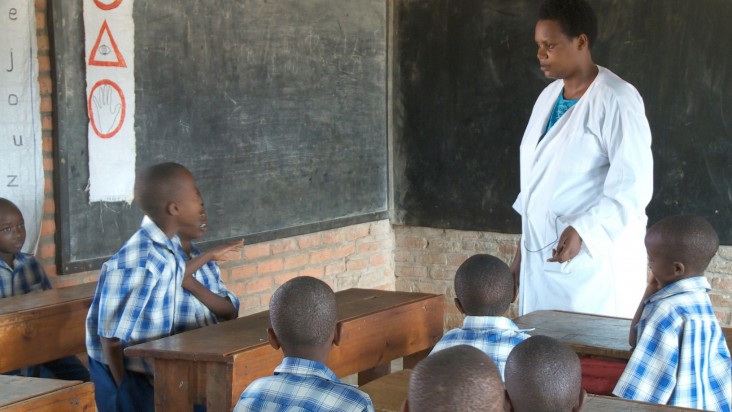
Feb. 2015—“I am interested in helping young children to become readers and writers,” says Pricille Uzanyinzoga, a first grade teacher at Remera Catholic, an elementary school in Rwanda’s capital of Kigali. Teaching children to read and write Kinyarwanda, Rwanda’s official language, is something Uzanyinzoga has been doing since 2003.
Uzanyinzoga and other first and second grade teachers at Remera Catholic have been working closely with USAID’s Literacy, Language and Learning project to support the development of interactive print and audio teaching and learning materials to support literacy and numeracy development.
Included in these materials, audio lessons feature children and a teacher who guide the classroom through an interactive lesson using games, songs and chants. Beginning in 2012, teachers at Remera Catholic, including Uzanyinzoga, were the first teachers in the country to use the lessons.
“At first, I felt that it was impossible to use audio in my lesson,” says Uzanyinzoga. “These are very new practices for teachers, also for learners.” The Remera Catholic teachers’ experience using the lessons helped to improve the development of the lessons. In time, Uzanyinzoga and the other teachers also became enthusiastic about this new way of instruction.
“I discovered that the audio is very helpful because children are very curious and they follow the lesson,” says Uzanyinzoga. “When children are listening to the Kinyarwanda songs, they are learning, they are motivated and they are happy.”
Students’ enjoyment wasn't the only result. Uzanyinzoga notes that, last year, she saw more children finishing first grade with solid reading skills. All public elementary schools in Rwanda—more than 2,400—began using the lessons as well in 2014. Schools received simple cell phones and portable speakers, as well as solar panels to charge them, to play the audio in their classrooms.
Now skilled at teaching with the new program, Uzanyinzoga has been supporting other teachers across the country. She says that, at first, other teachers doubted if she could help them because she was also a teacher.
“I gave them my experience,” she says. “And after helping them to understand more, I was proud of how my colleagues understood how to teach with the program.”
Uzanyinzoga has also been featured in training videos, which are used by mentors in schools across the country to train teachers. In the videos, Uzanyinzoga’s teaching is used as a model to demonstrate how teachers should conduct their lessons.
As for most people, changing habits and adopting new ways of doing things is never easy. Uzanyinzoga has seen that, with training, teachers are eager to use the materials in their classrooms. If teachers can gain this confidence, as she has, Uzanyinzoga believes the students will benefit.
“I'm sure that all Rwandan children will be able to read and write well, not only in Kinyarwanda, but also in English,” she says. “And they will also be able to do mathematics.”
USAID's five-year Literacy, Language and Learning project, implemented by the Education Development Center, began in 2011 and continues to support teachers across the country in using new, innovative teaching and learning materials.
LINKS
Follow @USAIDRwanda, on Facebook, on Flickr







Comment
Make a general inquiry or suggest an improvement.